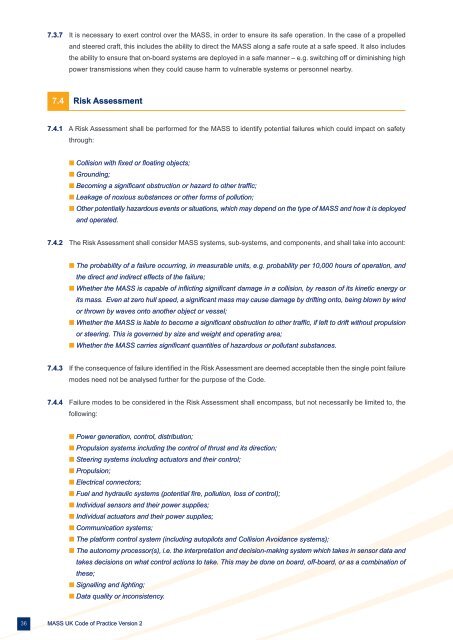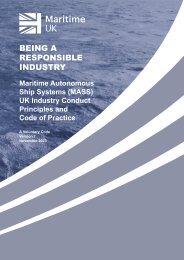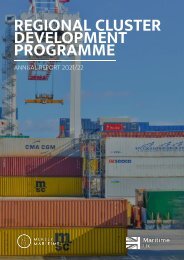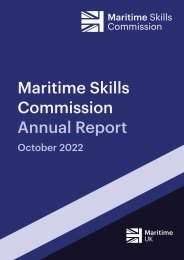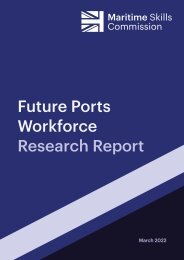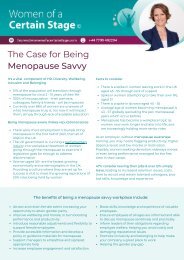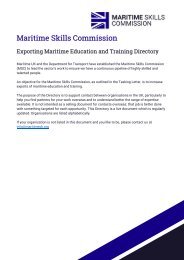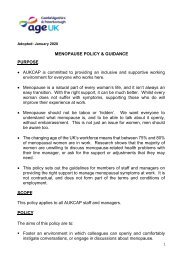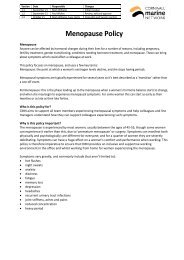Maritime UK MASS CoP v2
Create successful ePaper yourself
Turn your PDF publications into a flip-book with our unique Google optimized e-Paper software.
7.3.7 It is necessary to exert control over the <strong>MASS</strong>, in order to ensure its safe operation. In the case of a propelled<br />
and steered craft, this includes the ability to direct the <strong>MASS</strong> along a safe route at a safe speed. It also includes<br />
the ability to ensure that on-board systems are deployed in a safe manner – e.g. switching off or diminishing high<br />
power transmissions when they could cause harm to vulnerable systems or personnel nearby.<br />
7.4 Risk Assessment<br />
7.4.1 A Risk Assessment shall be performed for the <strong>MASS</strong> to identify potential failures which could impact on safety<br />
through:<br />
n Collision with fixed or floating objects;<br />
n Grounding;<br />
n Becoming a significant obstruction or hazard to other traffic;<br />
n Leakage of noxious substances or other forms of pollution;<br />
n Other potentially hazardous events or situations, which may depend on the type of <strong>MASS</strong> and how it is deployed<br />
and operated.<br />
7.4.2 The Risk Assessment shall consider <strong>MASS</strong> systems, sub-systems, and components, and shall take into account:<br />
n The probability of a failure occurring, in measurable units, e.g. probability per 10,000 hours of operation, and<br />
the direct and indirect effects of the failure;<br />
n Whether the <strong>MASS</strong> is capable of inflicting significant damage in a collision, by reason of its kinetic energy or<br />
its mass. Even at zero hull speed, a significant mass may cause damage by drifting onto, being blown by wind<br />
or thrown by waves onto another object or vessel;<br />
n Whether the <strong>MASS</strong> is liable to become a significant obstruction to other traffic, if left to drift without propulsion<br />
or steering. This is governed by size and weight and operating area;<br />
n Whether the <strong>MASS</strong> carries significant quantities of hazardous or pollutant substances.<br />
7.4.3 If the consequence of failure identified in the Risk Assessment are deemed acceptable then the single point failure<br />
modes need not be analysed further for the purpose of the Code.<br />
7.4.4 Failure modes to be considered in the Risk Assessment shall encompass, but not necessarily be limited to, the<br />
following:<br />
n Power generation, control, distribution;<br />
n Propulsion systems including the control of thrust and its direction;<br />
n Steering systems including actuators and their control;<br />
n Propulsion;<br />
n Electrical connectors;<br />
n Fuel and hydraulic systems (potential fire, pollution, loss of control);<br />
n Individual sensors and their power supplies;<br />
n Individual actuators and their power supplies;<br />
n Communication systems;<br />
n The platform control system (including autopilots and Collision Avoidance systems);<br />
n The autonomy processor(s), i.e. the interpretation and decision-making system which takes in sensor data and<br />
takes decisions on what control actions to take. This may be done on board, off-board, or as a combination of<br />
these;<br />
n Signalling and lighting;<br />
n Data quality or inconsistency.<br />
36<br />
<strong>MASS</strong> <strong>UK</strong> Code of Practice Version 2


